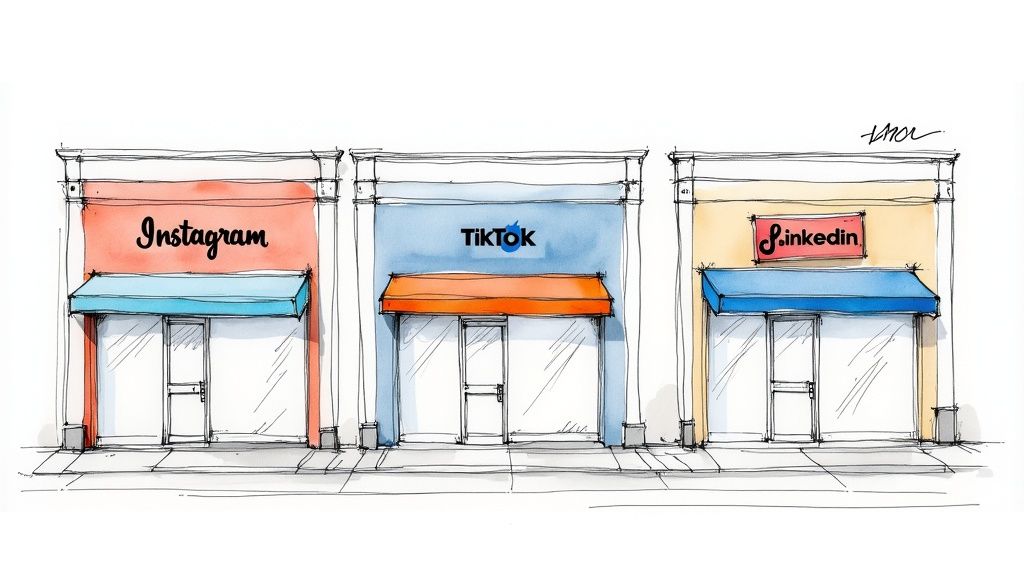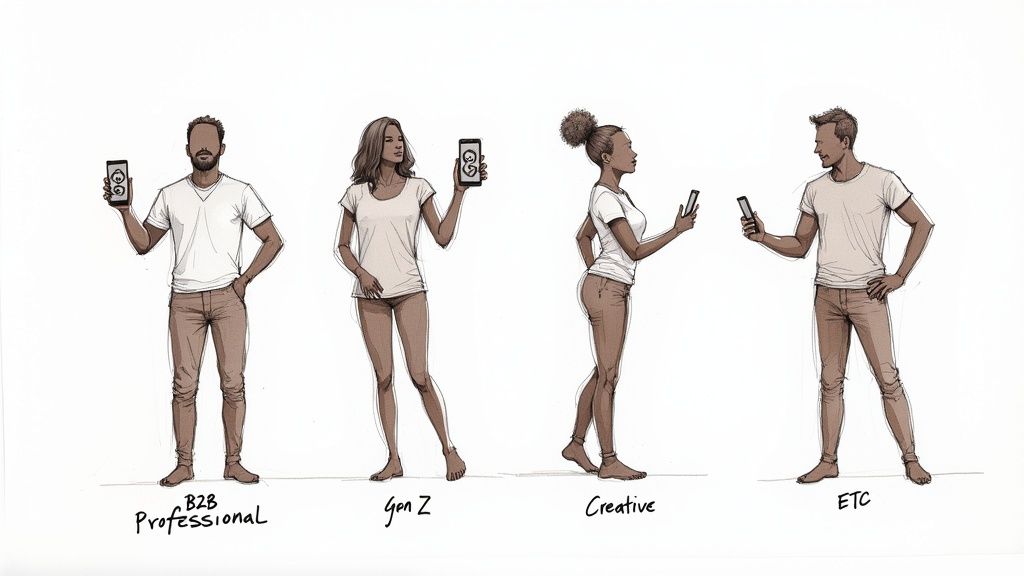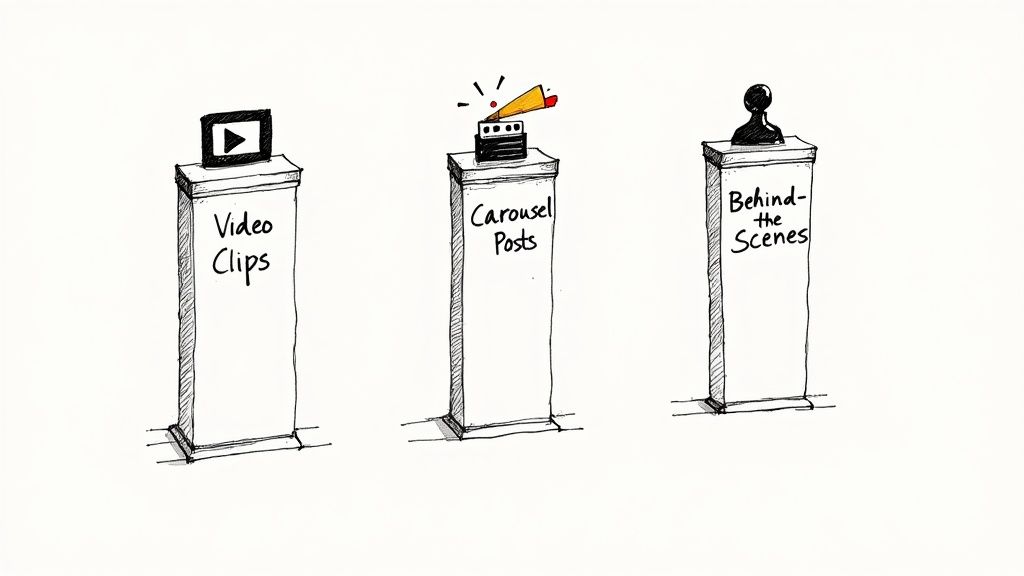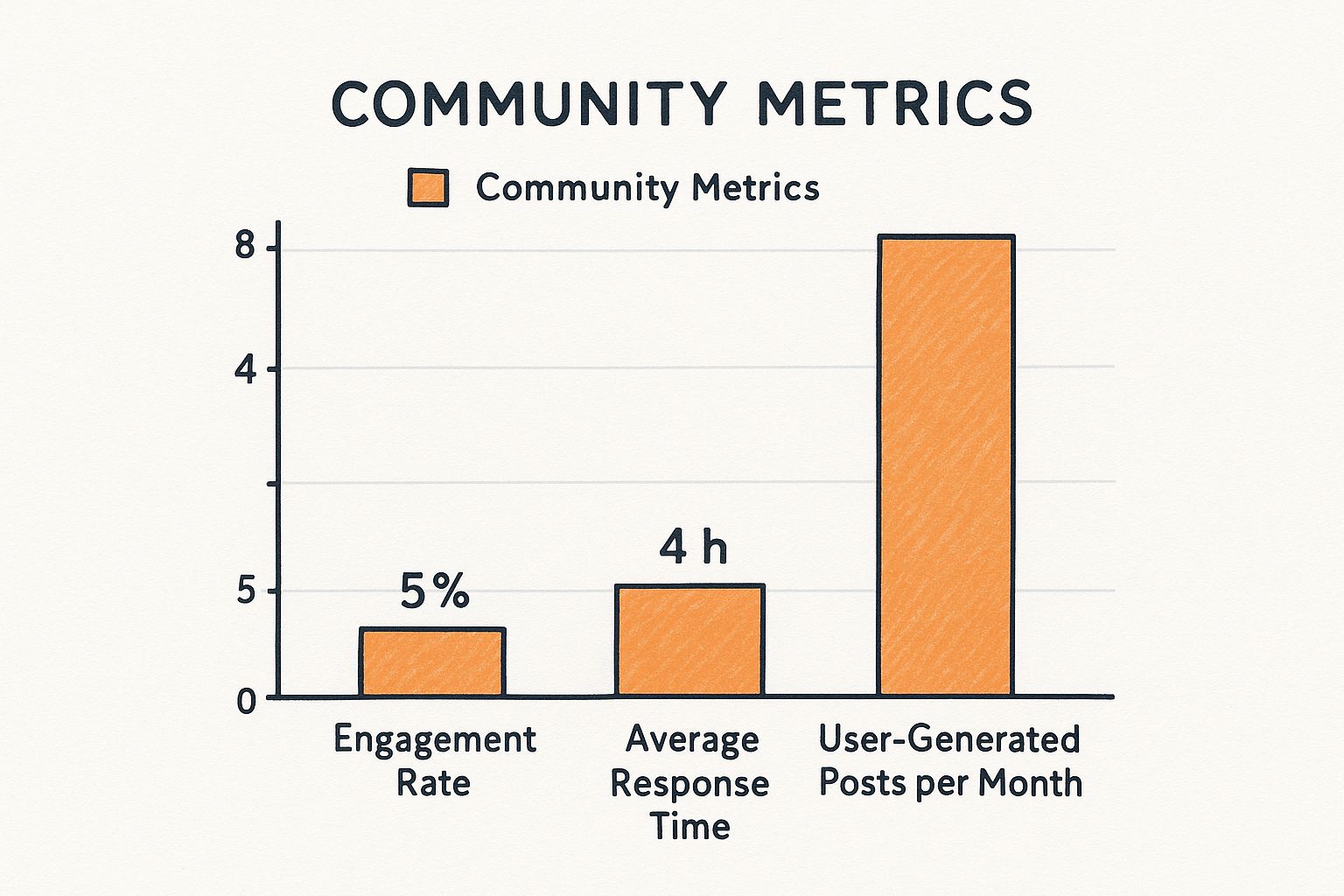
Oct 13, 2025
Ethan Monkhouse
So, you're asking, "How do I market my business on social media?" It's a question I hear all the time. The short answer? Figure out where your audience hangs out, create stuff that actually helps them, and show up consistently. It's not about shouting from every rooftop; it's about having the right conversations in the right rooms.
Why Social Media Is Your New Main Street

If your business isn't active on social media, you're basically invisible to a massive chunk of potential customers. Let’s be real, the days of relying only on foot traffic or a newspaper ad are long gone. Today, platforms like Instagram, TikTok, and LinkedIn are the new town square. It's where people find new brands, check out products, and decide who they want to do business with.
This isn't just a fleeting trend—it's a massive shift in how people shop and connect. In fact, a recent study showed that 58% of consumers now discover new businesses on social media. That’s more than traditional search engines and TV ads. People are spending, on average, 141 minutes a day scrolling through these apps. That's a huge opportunity you can't afford to miss.
Moving Beyond Just "Being There"
Just creating a profile and calling it a day won't cut it. You have to ditch the "we should probably be on social media" mindset and get strategic. Stop thinking of it as a billboard and start treating it like a community hub.
This is where you can:
Build real relationships by actually replying to comments and messages.
Show off your brand's personality with behind-the-scenes glimpses.
Get honest feedback straight from your customers.
Send targeted traffic right where you want it—to your products or services.
Think about it. A local coffee shop can use Instagram Stories to show off its latte art and daily specials, creating an immediate connection that gets people in the door that same afternoon. Or a B2B tech company can use LinkedIn articles to break down complex topics, positioning themselves as the go-to experts and attracting serious clients. These aren't just posts; they are conversations that build trust.
The real magic of social media isn't just broadcasting your message. It's about listening to the conversations already happening and finding your place in them. Authentic engagement will always beat loud promotion.
To really make this "new main street" work for you, you need a solid plan. A clear blueprint. I found this ultimate guide to social media strategy that does a great job of helping you build that foundation. Without a plan, you're just throwing content into the void and hoping something sticks.
So, let's break down what a truly effective strategy looks like. It all comes down to four key areas that you need to nail.
The Four Pillars of Social Media Marketing Success
Here’s a quick look at the core components we're about to unpack. Getting these four pillars right is the foundation for everything else you'll do.
Pillar | What It Means for You | Why It's a Game-Changer |
|---|---|---|
Strategy & Goals | Defining what you want to achieve and who you're talking to. | It turns random posts into a focused plan that actually drives business results. |
Content Creation | Making stuff your audience genuinely wants to see, share, and engage with. | Great content stops the scroll, builds trust, and makes people remember you. |
Execution & Management | The day-to-day work of posting, engaging, and managing your channels. | Consistency is king. This is where you build momentum and community. |
Analytics & Optimization | Looking at the data to see what’s working and doing more of it. | It's how you stop guessing and start making smart, data-backed decisions. |
Getting a handle on these four areas is your roadmap to success. Throughout the rest of this guide, we'll dive deep into each one, giving you actionable steps to build a social media presence that doesn't just look good, but actually grows your business.
Finding Your People and Your Platforms

Before you even think about writing a post or designing a graphic, you’ve got to answer two questions that will shape your entire social media strategy: Who are you really talking to, and where do they actually hang out online?
Trying to be everywhere at once is a classic rookie mistake. It’s a fast track to burnout and getting completely ignored. The goal isn't to shout into the digital void; it's to find the specific corners of the internet where your ideal customers are already having conversations and then join in.
The sheer scale of social media can feel overwhelming. As of 2025, there are something like 5.42 billion users scattered across the globe. The average person bounces between nearly seven different platforms a month. This just means your people are definitely out there—you just have to be smart about finding them.
Go Way Beyond Basic Demographics
First things first, you need to build out detailed customer personas. I'm not talking about a flimsy "Females, 25-40" description. A truly useful persona feels like a real person, a fictional character that represents your ideal customer. It needs to dig into their motivations, their daily frustrations, and their habits.
For example, think about "Marketing Manager Molly." She's 34, works at a mid-sized tech company, and her biggest headache is proving campaign ROI to her boss. She's scrolling LinkedIn on her lunch break, looking for actionable industry tips, not fluffy motivational quotes.
Then there's "Sustainable Shopper Sam." He's 25, passionate about eco-friendly living, and gets all his inspiration from visual-heavy platforms like Instagram and Pinterest. He follows brands that are refreshingly transparent and use authentic, beautiful imagery. He’s immediately turned off by corporate jargon and slick, impersonal ads.
Your goal is to know your ideal customer so well that you can predict what content will make them stop scrolling. What are their pain points? What makes them laugh? What problem can you solve for them right now?
Putting in the work to create these profiles is a non-negotiable step. If you need a hand, our guide on how to create buyer personas will walk you through it. This process doesn't just clarify your messaging; it tells you exactly which platforms are worth your time and energy.
Match Your Persona to the Right Platform
Once you have a crystal-clear picture of who you're talking to, picking the right platforms becomes so much easier. Every social network has its own unique culture, user expectations, and content style. A strategy that crushes it on one can fall completely flat on another.
Let's break down the general vibe of the major players:
LinkedIn: This is the office party of social media. People are here for professional development, industry news, and B2B solutions. It's the perfect spot for B2B companies, consultants, and anyone trying to build authority in their field.
Instagram: It's a visual-first world built on aesthetics, personality, and storytelling. This is a natural home for brands in fashion, food, travel, and design. Stories and Reels are your best friends for showing the real, behind-the-scenes personality of your business.
Facebook: With its massive, diverse user base, Facebook is a jack-of-all-trades. It's brilliant for building tight-knit communities in Groups and is a powerhouse for local businesses thanks to its hyper-specific ad targeting.
TikTok: The king of short-form video. It's all about creativity, jumping on trends, and pure entertainment. The algorithm loves authenticity, so it's a huge opportunity to reach younger audiences if your brand can loosen up and have some fun.
X (formerly Twitter): Think of it as the world's biggest water cooler. It's for real-time news, snappy conversations, and quick-fire customer service. It’s perfect for brands that want to be part of the daily conversation.
A law firm, for instance, would be smart to go all-in on LinkedIn, sharing deep-dive articles on legal trends. A local bakery, on the other hand, would thrive on Instagram, posting mouth-watering photos and using Stories to announce when the next batch is fresh out of the oven. The law firm's content would die a slow death on Instagram, and the bakery's posts would be totally out of place on LinkedIn.
By focusing on just one or two platforms where your ideal customer lives, you can pour your resources into creating truly great content that connects. That targeted approach is how you turn followers into fans, and eventually, into paying customers.
Crafting Content That Actually Connects

Alright, so you’ve figured out who you're talking to and where they hang out online. Now for the million-dollar question: what do you actually say to them?
You've probably heard the advice to "post consistently" a thousand times. But honestly, consistency without a plan is just a fast track to burnout. It's the difference between throwing random ingredients in a pot and hoping for the best versus following a recipe you know will create a delicious meal.
To really get anywhere, you need a content strategy. Don't let the term intimidate you—it's just a simple framework to guide what you create so you're not always guessing. This whole process kicks off with what we call content pillars.
Think of content pillars as the 2-4 core themes your brand will be known for. These are the big-picture topics you can return to again and again, making sure your content is always relevant to your audience and your business goals.
Building Your Content Pillars
Imagine your brand is a magazine. What would the main sections be? Those are your pillars.
For instance, if you run a local coffee shop, your pillars might look something like this:
The Perfect Brew: All about your specialty coffees, different brewing methods, and the stories behind your beans.
Community Hub: This is where you'd feature local artists, share customer stories, and promote the events you're hosting.
Behind the Counter: A peek behind the curtain! Introduce your awesome baristas and show a "day in the life" of the shop.
But for a B2B software company, that wouldn't make sense. Their pillars would be completely different:
Industry Insights: Breaking down complex trends and offering your expert take on what's happening in your field.
Product Mastery: Pro-tips, tutorials, and case studies showing clients how to get incredible results with your software.
Team & Culture: Putting a face to the name by spotlighting the experts behind the product and sharing what your company is all about.
See how that works? Pillars give your creativity a playground to live in. Instead of staring at a blank screen, you can just ask, "What's something interesting I can share under 'The Perfect Brew' today?" It makes brainstorming so much easier.
If you want to go deeper on this, our guide on building a powerful content strategy for social media is a great next step.
Matching Content Formats to Your Message
Okay, you've got your pillars. Now, how do you package those ideas?
Not every idea works as a Reel, and not every thought needs to be a long-form article. Choosing the right format for the right platform can make a massive difference in how well your message lands.
Let's stick with our examples.
Local Coffee Shop (Instagram & Facebook Focus)
Instagram Stories: Perfect for that immediate, "in-the-moment" stuff. Think daily specials, Q&As with your head barista, or polls asking which new pastry to add to the menu.
Instagram Reels: Great for short, entertaining videos. A satisfying latte art pour, a quick tutorial on using a French press at home, or introducing the "dog of the day" that visits the cafe.
Carousel Posts: Use these to break down info into easy-to-digest slides. You could explain the difference between light and dark roasts or walk people through your loyalty program.
B2B Software Company (LinkedIn Focus)
LinkedIn Articles: This is your home for thought leadership. Post in-depth analyses of industry reports or detailed case studies.
Short Video Clips (with captions!): Think quick, subtitled videos for the feed. These could be snippets from a webinar, an executive sharing one key tip, or a fast demo of a new feature.
Text & Image Posts: Perfect for sharing quick insights, company news, or celebrating a team win. They’re fantastic for starting conversations.
The best social media content never feels forced. It looks like it belongs on the platform. A slick corporate video might get tons of engagement on LinkedIn, but it would feel completely out of place on your casual Instagram Stories feed.
Once you have a feel for the platforms, you'll need a steady stream of inspiration. You can explore fresh content ideas for social media to keep things from getting stale.
Creating a Simple Content Calendar
Last but not least, you need a way to keep all of this organized. A content calendar sounds formal, but it doesn't have to be some overly complicated spreadsheet. A simple Google Sheet or even a physical wall calendar will do the trick when you're starting out.
For every post you plan, your calendar just needs to answer four simple questions:
When is this going out? (Date & Time)
Where is it being posted? (Instagram Feed, LinkedIn, etc.)
What's the main point? (The caption and key message)
Which content pillar does it support? (This helps you keep a healthy mix)
Planning ahead like this is a game-changer. It turns social media from a reactive, stressful chore into a proactive, manageable part of your marketing. It also lets you "batch" your work—like shooting all your videos for the week in one afternoon—which frees you up to focus on the fun part: actually talking with your community.
Turning Followers Into a Community
Okay, so you've got a content plan. That’s fantastic, but it’s really only half the job. Now comes the part where the real work—and the real magic—happens. A strategy is just a piece of paper until you bring it to life, and just blasting posts into the digital ether is a one-way ticket to being ignored.
The big shift you need to make is from thinking like a publisher to acting like a community builder. This is about more than just scheduling posts. It's about the daily grind of fostering real connections. We're talking about writing captions that don't just state the obvious but actually start a conversation, turning those passive scrollers into people who actually care and engage.
Writing Captions That Spark Conversation
Think of your caption as the personality of your post. A killer photo or video might stop the scroll, but it's the caption that makes people stick around, drop a comment, and feel connected. The best ones I've seen almost always ask a question, share a relatable story, or offer a genuinely useful tip.
Instead of posting a photo of your new product and just saying, "New product available now," let's get creative. Imagine a local bookstore posts a pic of a new fantasy novel. Instead of a boring caption, they could ask, "If you could only recommend ONE fantasy book to a friend, what would it be and why? We'll go first..."
This simple tweak is incredibly powerful for two reasons:
It invites people in: You're not just talking at them; you're asking for their opinion, which everyone loves to give.
It builds a shared space: All of a sudden, your comments section is buzzing with recommendations and debates among people who share a passion.
Mastering the Art of Community Management
This is easily the most critical—and most forgotten—part of social media. Community management is the day-in, day-out work of listening to your audience, talking back, and actually engaging with them. It’s all about making people feel seen and heard.
Responding to comments is absolutely non-negotiable. Seriously. Even a quick "Thanks so much for sharing!" or a thoughtful answer to a question shows there's a real person behind the screen. It also helps you with the algorithm; platforms like Instagram love posts with lots of engagement, and that includes active comment threads. A fast reply can give your post a nice little visibility bump.
Don't just reply to comments—ignite conversations within them. Ask a follow-up question. Tag another person who might have a great answer. The aim is to turn a single comment into its own little party.
Answering your DMs (Direct Messages) quickly is just as important. A DM is a huge buying signal. Someone is taking the time to message you privately, which usually means they're a hot lead or a loyal customer needing help. When you treat your DMs with the same urgency as your main customer service line, you build an incredible amount of trust.
This infographic breaks down a few of the key things that community-focused brands keep their eyes on.

What you're seeing here is the blueprint for a healthy community: a solid engagement rate, a quick response time that shows you care, and a steady stream of user-generated content, which is the ultimate sign of a loyal following.
Encouraging User-Generated Content
User-Generated Content (UGC) is the absolute gold standard of community building. When your customers love your brand so much that they post about it themselves, you get the most authentic and powerful social proof imaginable. It’s word-of-mouth for the digital age, and it’s way more believable than any ad you could ever pay for.
So, how do you get more of it?
Create a Branded Hashtag: Come up with something simple and memorable. A fitness clothing brand, for instance, could use #MoveWithMomentum and feature the best customer posts on their own feed.
Run Contests: Ask followers to share a photo using your product for a chance to win something cool. This always creates a ton of buzz and a flood of great content.
Just Ask! It sounds simple, but it works. In your captions or Stories, prompt your audience to share their experiences. A travel company might say, "Share your favorite photo from your trip with us for a chance to be featured!"
When you reshare UGC (always ask for permission and give them credit!), you're doing more than just filling your content calendar. You're celebrating your customers, making them feel like stars, and showing potential new followers that you have an army of happy fans. It’s a feedback loop that turns a one-time buyer into a lifelong advocate for your brand.
Measuring What Matters for Real Growth
Alright, you're putting in the work. You’re crafting great content and engaging with your community. But how do you actually know if any of it is paying off? Are your social media efforts driving real business results, or are you just making noise?
This is where so many people get tripped up. It’s easy to get fixated on the numbers that look good on the surface—the vanity metrics—but don't really mean a thing for your bottom line. A huge follower count is nice, but if none of those people are clicking, engaging, or buying, it’s just a number.
The real goal here is to build a powerful feedback loop. You post, you measure, you learn, and then you adjust. This is the secret sauce that transforms social media from a guessing game into a predictable growth engine for your business.
Look Beyond Likes and Follows
To get a true picture of your performance, you have to track metrics that actually line up with your business goals. Are you trying to get more people to your website? Generate leads? Boost online sales? Your key metrics should directly reflect that mission.
Forget the fluff. Here are the numbers that really matter:
Engagement Rate: This is the big one. It’s the percentage of your audience that actually interacts with your content—think likes, comments, shares, and saves. A high engagement rate is a dead giveaway that your content is hitting the mark with the people you’re trying to reach.
Reach and Impressions: Reach tells you how many unique people saw your post. Impressions tell you the total number of times it was displayed. Tracking your reach is the best way to understand just how far your message is spreading.
Website Clicks: This one is critical. It shows you how effective your social media is at sending traffic to your digital home base. It’s the direct bridge between your social efforts and potential sales opportunities on your website.
Conversions: This is the ultimate proof of success. A conversion happens when someone takes a specific action you want them to, like signing up for your newsletter, downloading an ebook, or making a purchase.
You don't need to shell out cash for fancy software to get started. Every major platform has powerful, free analytics tools built right in. Instagram Insights and Facebook's Meta Business Suite are surprisingly robust and give you everything you need to see what's working and why.
For a deeper dive, our guide on measuring social media ROI can help you connect all the dots.
Your data tells a story. A post with tons of likes but zero clicks might be great for brand awareness, but a post with fewer likes and a high click-through rate is what actually drives business growth. Pay attention to the stories your numbers are telling you.
Using AI for Smarter Insights
Once you've got a handle on the basics, you can start using more advanced tools to find an edge. This is where AI is becoming a complete game-changer for social media marketing.
Modern tools can chew through data at a scale and speed that we just can't match.
AI-powered analytics can help you:
Spot Hidden Trends: AI can sift through mountains of data to identify emerging topics and content formats that are gaining traction with your audience—often before they become mainstream.
Analyze Competitor Performance: These tools keep an eye on what your competitors are up to, flagging what’s working for them and where they might be dropping the ball. This can reveal some incredible opportunities for you to stand out.
Optimize Ad Spend: For paid campaigns, AI can analyze performance in real-time to automatically shift your budget toward the ads and audiences delivering the best results, maximizing your return.
This isn’t just about automation; it’s about making smarter, faster decisions. It's no surprise that by 2025, AI is expected to play a major strategic role in social media decision-making. In fact, more than three-quarters of social strategy leaders are already using AI because it helps them adapt faster and be more effective.
From Data to Actionable Decisions
Let's be clear: gathering data is completely pointless if you don't do anything with it. The final, most important step is turning all those numbers into real-world action.
Set aside some time each month to review your analytics. This isn't about creating a boring report; it's about looking for clues.
Here’s a simple way to think about what the most important metrics are telling you.
Key Social Media Metrics and What They Mean
Metric | How to Calculate It | Why It Matters to Your Business |
|---|---|---|
Engagement Rate | (Likes + Comments + Shares + Saves) / Followers | Shows if your content resonates. High engagement means a loyal, interested audience that is more likely to convert. |
Reach | The number of unique users who saw your post. | Measures brand awareness. Tells you how far your content is spreading beyond your immediate followers. |
Website Clicks | Clicks on the link in your bio or in your posts. | Measures traffic generation. Directly shows how many people are moving from social media to your website to learn more or buy. |
Conversions | Users who complete a desired action (e.g., sign-up, purchase). | Measures direct business impact. This is the ultimate ROI metric that connects social media activity to actual revenue. |
Once you have this data, you can start making informed adjustments. If your video content is getting double the engagement of static images, that’s a loud-and-clear signal to start creating more videos. If posts published in the evening consistently get more reach, it’s time to tweak your posting schedule.
This constant cycle of measuring, learning, and optimizing is what turns social media from a chore into a powerful tool for real, sustainable growth.
Got Questions? Let's Get Them Answered.
Even with the best roadmap, you’re bound to hit some specific bumps along the way. Social media is always shifting, so it's natural for questions to come up. Let's dig into some of the most common ones I hear all the time and give you some straight answers.
How Often Should I Be Posting?
Ah, the million-dollar question. The honest, no-fluff answer? It depends. The old-school advice of "post three times a day, no matter what" is officially dead. Today, it’s all about quality over quantity.
Seriously, one fantastic post that gets people talking is worth more than five mediocre ones that get scrolled past. The algorithms on every platform are designed to reward engagement, not just frequency.
If you need a baseline, here are some solid starting points:
Instagram (Feed): 3-5 times a week is a great rhythm.
Facebook: 1-2 times a day usually works well.
LinkedIn: Think business hours, so 3-5 times a week makes sense.
TikTok: This one's a bit different. The platform loves fresh content, so if you can manage it without sacrificing quality, aim for 1-3 times a day.
The most important thing here is consistency. Pick a schedule you can actually maintain. It’s far better to deliver three killer posts a week, every single week, than to go hard for two weeks and then vanish because you burned out.
How Much Money Do I Need for Social Media Ads?
You can relax—you don't need a Fortune 500 budget to get started with paid ads. A lot of businesses get great results by starting small and testing the waters first.
I always recommend starting with $5 to $10 per day for your first campaign. That's all you need to start collecting some really useful data about what’s resonating with your audience and what isn't.
Think of that initial budget as an investment in learning, not an immediate sales machine. For just a few hundred bucks a month, you can discover which ad images, headlines, and audiences are your winners. Once you find that magic combination, you can start scaling up your budget with confidence, knowing you're putting your money where it will actually make a difference.
What’s the Best Way to Handle Negative Comments?
First off, don't panic. A negative comment isn't a crisis—it’s actually an opportunity. The way you respond shows everyone watching what your brand is really made of.
Here's my simple, three-step process for handling criticism like a pro:
Acknowledge and Validate Publicly: Jump on it quickly. A simple, public reply like, "We're so sorry to hear you had this issue," goes a long way. It shows you're paying attention.
Move the Conversation Offline: The goal is to resolve this privately. Follow up with something like, "Could you please send us a DM with your order number? Our team wants to make this right."
Don't Delete (Unless You Absolutely Have To): The only time you should hit that delete button is if a comment is pure spam, abusive, or contains hate speech. Deleting a legitimate complaint makes you look guilty and almost always fans the flames.
When you handle negative feedback with grace, you can turn an unhappy customer into one of your biggest fans. Plus, you're showing potential customers that you’re a business that truly cares and stands by its service.
Ready to stop guessing and start growing? Naviro is the AI growth engine that turns social media data into your competitive advantage. Analyze what's working, create content that connects, and build a strategy that delivers real results. Unlock your social media potential with Naviro today.



